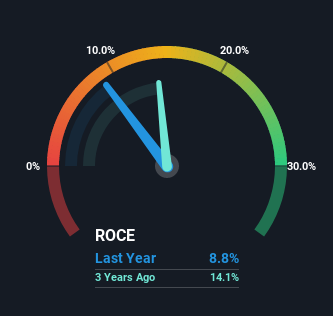- United States
- /
- Consumer Durables
- /
- NasdaqGS:HELE
Helen of Troy (NASDAQ:HELE) May Have Issues Allocating Its Capital

If we want to find a potential multi-bagger, often there are underlying trends that can provide clues. Typically, we'll want to notice a trend of growing return on capital employed (ROCE) and alongside that, an expanding base of capital employed. Basically this means that a company has profitable initiatives that it can continue to reinvest in, which is a trait of a compounding machine. However, after briefly looking over the numbers, we don't think Helen of Troy (NASDAQ:HELE) has the makings of a multi-bagger going forward, but let's have a look at why that may be.
Understanding Return On Capital Employed (ROCE)
If you haven't worked with ROCE before, it measures the 'return' (pre-tax profit) a company generates from capital employed in its business. Analysts use this formula to calculate it for Helen of Troy:
Return on Capital Employed = Earnings Before Interest and Tax (EBIT) ÷ (Total Assets - Current Liabilities)
0.088 = US$234m ÷ (US$3.2b - US$583m) (Based on the trailing twelve months to August 2022).
Thus, Helen of Troy has an ROCE of 8.8%. In absolute terms, that's a low return and it also under-performs the Consumer Durables industry average of 17%.
View our latest analysis for Helen of Troy

Above you can see how the current ROCE for Helen of Troy compares to its prior returns on capital, but there's only so much you can tell from the past. If you'd like to see what analysts are forecasting going forward, you should check out our free report for Helen of Troy.
What Does the ROCE Trend For Helen of Troy Tell Us?
When we looked at the ROCE trend at Helen of Troy, we didn't gain much confidence. Around five years ago the returns on capital were 12%, but since then they've fallen to 8.8%. However it looks like Helen of Troy might be reinvesting for long term growth because while capital employed has increased, the company's sales haven't changed much in the last 12 months. It may take some time before the company starts to see any change in earnings from these investments.
What We Can Learn From Helen of Troy's ROCE
In summary, Helen of Troy is reinvesting funds back into the business for growth but unfortunately it looks like sales haven't increased much just yet. Unsurprisingly, the stock has only gained 16% over the last five years, which potentially indicates that investors are accounting for this going forward. As a result, if you're hunting for a multi-bagger, we think you'd have more luck elsewhere.
If you'd like to know about the risks facing Helen of Troy, we've discovered 1 warning sign that you should be aware of.
While Helen of Troy isn't earning the highest return, check out this free list of companies that are earning high returns on equity with solid balance sheets.
Valuation is complex, but we're here to simplify it.
Discover if Helen of Troy might be undervalued or overvalued with our detailed analysis, featuring fair value estimates, potential risks, dividends, insider trades, and its financial condition.
Access Free AnalysisHave feedback on this article? Concerned about the content? Get in touch with us directly. Alternatively, email editorial-team (at) simplywallst.com.
This article by Simply Wall St is general in nature. We provide commentary based on historical data and analyst forecasts only using an unbiased methodology and our articles are not intended to be financial advice. It does not constitute a recommendation to buy or sell any stock, and does not take account of your objectives, or your financial situation. We aim to bring you long-term focused analysis driven by fundamental data. Note that our analysis may not factor in the latest price-sensitive company announcements or qualitative material. Simply Wall St has no position in any stocks mentioned.
About NasdaqGS:HELE
Helen of Troy
Provides various consumer products in the United States, Canada, Europe, the Middle East, Africa, the Asia Pacific, and Latin America.
Low and slightly overvalued.
Similar Companies
Market Insights
Community Narratives



